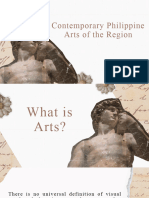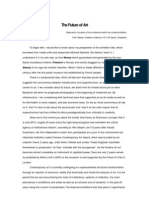0 ratings0% found this document useful (0 votes)
4 viewsArts
Arts
Uploaded by
pooandpeelolQuestion ideas regarding arts essays
Copyright:
© All Rights Reserved
Available Formats
Download as DOCX, PDF, TXT or read online from Scribd
Arts
Arts
Uploaded by
pooandpeelol0 ratings0% found this document useful (0 votes)
4 views2 pagesQuestion ideas regarding arts essays
Copyright
© © All Rights Reserved
Available Formats
DOCX, PDF, TXT or read online from Scribd
Share this document
Did you find this document useful?
Is this content inappropriate?
Question ideas regarding arts essays
Copyright:
© All Rights Reserved
Available Formats
Download as DOCX, PDF, TXT or read online from Scribd
Download as docx, pdf, or txt
0 ratings0% found this document useful (0 votes)
4 views2 pagesArts
Arts
Uploaded by
pooandpeelolQuestion ideas regarding arts essays
Copyright:
© All Rights Reserved
Available Formats
Download as DOCX, PDF, TXT or read online from Scribd
Download as docx, pdf, or txt
You are on page 1of 2
The Arts
Influence of Technology on Artistic Expression:
Digital Art Forms and New Media:
o Technology has introduced digital art forms such as computer-
generated imagery, digital painting, and interactive
installations. These new media offer artists innovative tools for
creation and new ways to engage audiences.
The Role of Social Media in Promoting Artists:
o Social media platforms like Instagram and Twitter enable
artists to reach wider audiences and build personal brands.
These platforms facilitate direct interaction with fans and
potential buyers, and offer opportunities for viral exposure.
Impact of Virtual Reality and Augmented Reality on Art Experiences:
o Virtual reality (VR) and augmented reality (AR) provide
immersive experiences that allow audiences to interact with
and explore art in novel ways. VR can create entirely virtual
exhibitions, while AR can overlay digital elements onto
physical artworks.
Cultural Significance of Art Movements:
Historical Context of Major Art Movements (e.g., Impressionism,
Modernism):
o Art movements such as Impressionism and Modernism reflect
historical and cultural shifts, offering insight into the social
and political climates of their times. These movements
introduced new techniques and philosophies that challenged
traditional norms.
Impact of Art Movements on Society and Politics:
o Art movements often respond to and influence societal and
political issues, shaping public discourse and challenging
existing power structures. For example, political art can raise
awareness about social injustices or inspire social change.
Evolution of Art Criticism and Theory:
o Art criticism and theory have evolved from formalistic
approaches to more diverse and inclusive frameworks. This
evolution reflects broader changes in how art is interpreted
and valued, incorporating various perspectives and
methodologies.
Representation and Identity in the Arts:
Exploration of Race, Gender, and Identity in Contemporary Art:
o Contemporary art frequently addresses themes of race,
gender, and identity, reflecting diverse experiences and
perspectives. This exploration challenges stereotypes and
promotes dialogue about social issues.
Influence of Artists' Backgrounds on Their Work:
o An artist's cultural, personal, and socio-economic background
can profoundly shape their work. Understanding an artist's
background provides deeper insight into their creative process
and the themes they address in their art.
Role of Art in Social Justice and Activism:
o Art serves as a powerful tool for social justice and activism,
highlighting issues such as inequality, human rights, and
environmental concerns. Through various mediums, artists
can engage audiences, raise awareness, and advocate for
change.
You might also like
- Influence of Art On SocietyDocument1 pageInfluence of Art On Societya8257448No ratings yet
- Modern ArtDocument4 pagesModern ArtrengaboyfiesNo ratings yet
- Art EssayDocument2 pagesArt EssaymanufaceconsultantsNo ratings yet
- LacyDocument12 pagesLacyMarzo IfyouneedNo ratings yet
- The Role of Art in Social Change A Historical and Contemporary AnalysisDocument2 pagesThe Role of Art in Social Change A Historical and Contemporary Analysisminept2000No ratings yet
- The New Renaissance: How Art, Culture, and Tech Are Shaping Tomorrow’s WorldFrom EverandThe New Renaissance: How Art, Culture, and Tech Are Shaping Tomorrow’s WorldNo ratings yet
- Art Activism: Not Just Visual Appeal But A Catalyst For Social ChangeDocument26 pagesArt Activism: Not Just Visual Appeal But A Catalyst For Social ChangeIJAR JOURNALNo ratings yet
- Arts 1 Final PaperDocument8 pagesArts 1 Final Papermichellemariano629No ratings yet
- Art in The 21st CenturyDocument3 pagesArt in The 21st CenturyLhyn Liam-LameraNo ratings yet
- Lesson 9Document3 pagesLesson 9swanvenusianNo ratings yet
- Art and CultureDocument6 pagesArt and Culturemonakhanawan12345678No ratings yet
- Academic PresentationDocument2 pagesAcademic PresentationSri chyniNo ratings yet
- Art of 21st CenturyDocument7 pagesArt of 21st CenturyAnamika ShabnamNo ratings yet
- Supplemental Reading 1-CPARDocument4 pagesSupplemental Reading 1-CPARAngelu MalvarNo ratings yet
- Art RevolutionDocument3 pagesArt Revolutionwlaw1668No ratings yet
- Claire-Bishop Social TurnDocument17 pagesClaire-Bishop Social TurnLa Galeria de ComercioNo ratings yet
- Avant-Garde Art and ArtistsDocument6 pagesAvant-Garde Art and ArtistsVictor100% (1)
- Study OnsDocument24 pagesStudy Onsapi-335648690No ratings yet
- Art of Activism On Social and Political ThemeDocument10 pagesArt of Activism On Social and Political Theme123456No ratings yet
- Very Important IntroductionDocument6 pagesVery Important IntroductionGrațiela GraceNo ratings yet
- EssayDocument3 pagesEssaydenniseescobido07No ratings yet
- The City and I: The Impact of The Community On The City Identity A Digital Printmaking Approach (An Analytical Critical Study)Document8 pagesThe City and I: The Impact of The Community On The City Identity A Digital Printmaking Approach (An Analytical Critical Study)IEREKPRESSNo ratings yet
- The Impact of Street Art On Urban Culture and SocietyDocument5 pagesThe Impact of Street Art On Urban Culture and Societyvishruth92No ratings yet
- On The Neoliberal StageDocument8 pagesOn The Neoliberal StagedoragreenissleepyNo ratings yet
- Will Bradley Art and Social Change IntroductionDocument12 pagesWill Bradley Art and Social Change IntroductionLuka JurićNo ratings yet
- The InterventionistsDocument20 pagesThe Interventionistscalista3lucilleNo ratings yet
- Art and Fear of PropagandaDocument11 pagesArt and Fear of PropagandanataliNo ratings yet
- Bishop, Claire - The Social Turn, Collaboration and Its Discontents-1Document7 pagesBishop, Claire - The Social Turn, Collaboration and Its Discontents-1Belén Gómez de la TorreNo ratings yet
- Mike NandalaDocument20 pagesMike NandalazakNo ratings yet
- The Role of Art in SocietyDocument1 pageThe Role of Art in Societylucia.gray.crimsonNo ratings yet
- Module 8 10 ArtDocument13 pagesModule 8 10 ArtcyrusjojieNo ratings yet
- Creative Cities A 10-Year Research AgendaDocument24 pagesCreative Cities A 10-Year Research AgendaMelissa Ann PatanoNo ratings yet
- Cpar - Lesson 1-3Document50 pagesCpar - Lesson 1-3danielhandig.bragaisNo ratings yet
- Social Media and Contemporary Art A TheoDocument11 pagesSocial Media and Contemporary Art A TheoNana Ama AndamNo ratings yet
- 1 Gad LDG Crsi 2018Document6 pages1 Gad LDG Crsi 2018Phạm Phương LinhNo ratings yet
- Introduction To Street ArtDocument7 pagesIntroduction To Street Artfalconace94No ratings yet
- What Is Art? Why Is Art Important?Document9 pagesWhat Is Art? Why Is Art Important?Paula BatulanNo ratings yet
- The Artist and Its Connection To The ArtworkDocument8 pagesThe Artist and Its Connection To The Artworkkim broquezaNo ratings yet
- Cit-U Art Ap Abstraction 2 2425Document4 pagesCit-U Art Ap Abstraction 2 2425rhynmontayre025No ratings yet
- Laikwan Pang. Arendt in Hong KongDocument18 pagesLaikwan Pang. Arendt in Hong KongRay LaiNo ratings yet
- Ranciere Jacques Interview With Fulvia Carnevale and John KelseyDocument20 pagesRanciere Jacques Interview With Fulvia Carnevale and John KelseyDavidNo ratings yet
- Contemporary Vs Modern ArtDocument3 pagesContemporary Vs Modern ArtMR éxypnosNo ratings yet
- Alexander and Bowler Final TypescriptDocument51 pagesAlexander and Bowler Final TypescriptJazmín SandovalNo ratings yet
- The Future of ArtDocument2 pagesThe Future of Artzian chenNo ratings yet
- Report NiyoDocument21 pagesReport Niyosiremma011No ratings yet
- Art AppreciationDocument1 pageArt AppreciationKaela LorNo ratings yet
- The Role of Art in SocietyDocument2 pagesThe Role of Art in SocietyshijovargheseNo ratings yet
- Street Art: A Semiotic RevolutionDocument8 pagesStreet Art: A Semiotic Revolutionanaktazija100% (1)
- Intro To ArtDocument8 pagesIntro To ArtYowhNo ratings yet
- Art As A Public IssueDocument2 pagesArt As A Public IssueSijia GaoNo ratings yet
- Historical Perspective of Arts: TopicDocument5 pagesHistorical Perspective of Arts: TopicMarivic NopreNo ratings yet
- The Importance of Being An ArtistDocument2 pagesThe Importance of Being An Artistmert yigidNo ratings yet
- Differentiating Art History From Art AppreciationDocument35 pagesDifferentiating Art History From Art AppreciationHadji VillaflorNo ratings yet
- Afterimage 22 (January 1995)Document39 pagesAfterimage 22 (January 1995)Lei RmzNo ratings yet
- Grant Kester Aesthetic AevangelistDocument39 pagesGrant Kester Aesthetic AevangelistfrejzerNo ratings yet
- Hou Hanru - Acting Out Into The City - Artistic Intervention As Production of Urban Public SpaceDocument4 pagesHou Hanru - Acting Out Into The City - Artistic Intervention As Production of Urban Public SpacediuhsdknjsdNo ratings yet
- Art and Urban Design: Sociology & UrbanismDocument8 pagesArt and Urban Design: Sociology & UrbanismkhushbuNo ratings yet
- What Is Participat Roy and Relational ArtDocument15 pagesWhat Is Participat Roy and Relational ArtSarah BrowneNo ratings yet
- Arts Impact On Political and Economic DiscouresDocument19 pagesArts Impact On Political and Economic DiscouresLaksha ChoudharyNo ratings yet
- What Is ArtDocument16 pagesWhat Is Artgawik gawikNo ratings yet



























































